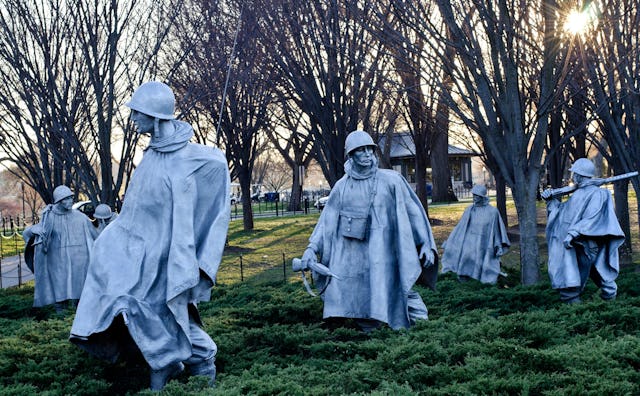PTSD and the Art of Desensitization

There’s a sliver of something like irony wedged into our observance of Veterans Day, and it has to do with memory. For some veterans, the price of combat is more than physical. Summer road trips and fireworks are left to fade, and war-fighters’ memories—often young war-fighters’ memories—are filled with images of other explosions. Gunfire and collapse, dry sand and trauma. Sometimes this is where it stops, but for those soldiers whose brains process the trauma differently, whose brains get stuck in the trenches of post-traumatic stress disorder, the memories are ravaged, ground up, cold, and recurring.
In the case of PTSD, what is broken can sometimes be fixed. For civilians and veterans alike, a wide range of treatments exists for the condition. While no two cases are exactly alike, the clinically validated treatments—including cognitive behavioral therapy and antidepressants like Prozac and Zoloft—can often help many patients. But we still don’t have a cure.
The absence of a one-size-fits-all therapy for PTSD has encouraged a legion of researchers to develop a number of experimental treatments, the diversity of which is a testament to PTSD’s own. Emerging evidence points toward an alphabet of other options: from acupuncture to xenon gas; from anti-epileptic drugs to yoga; from dog and horse therapy to virtual reality exposure.
While many of the new potential treatments require further testing, the hope is that with more options comes a higher chance of a tailored treatment experience and greater recovery rates. It’s not the most efficient approach, but given our current understanding of the condition, the individualized approach to treatment is the best we can do.
© Department of Defense Photo
Desensitization can be a good thing
The key to many treatment and prevention options for PTSD is desensitization. Given the shock-and-awe tactics of modern media, the word is usually a bad one. But PTSD implies a reworking of the brain’s fear networks: an inability to extinguish fear memories and an aberrant association between neutral experiences—triggers—and traumatic recall. With PTSD, desensitization is often exactly what we need.
Many of the PTSD treatments with the strongest evidence base target this process. Eye movement desensitization and reprocessing (EMDR), for example, pairs a patient’s recounting of a traumatic memory with steady side-to-side eye movements guided by the therapist. While it’s a bit unclear (biologically speaking) why the treatment works, the protocol can often render the traumatic memory neutral. Variants of cognitive behavioral therapy like cognitive processing therapy and prolonged exposure seek similar goals: By recounting traumatic experiences again and again, it seems that patients can fully process the memories, shifting them from the traumatic to the banal. If we imagine that these therapies are targeting similar neural circuits and processes as those affected by antidepressants—to be sure, a contentious claim—it’s also possible to conceptualize antidepressants as accomplishing the same goal of memory reprocessing.
But if every case is different, how can therapists tailor treatments to their patients? And what about prevention?
Virtual reality therapy may prove useful in answering both of these questions. In virtual reality paradigms, patients with PTSD—or indeed, soldiers seeking resilience training before deployment—are immersed in virtual worlds that aid the process of desensitization. Programs like the University of Southern California Institute for Creative Technologies’ Virtual Iraq/Afghanistan allow users to experience potentially traumatic events (whether their own or those manufactured by a lab technician) over and over again. In a documentary interview with Vice, Dr. Albert Rizzo, the leader of the USC research effort, called the program an “emotional obstacle course.”
The treatment option is now available at more than 60 sites, including VA hospitals, universities, and military bases.
The other front line
“The sad part about war is, of course, it sucks,” says Dr. Rizzo in the same Vice interview. “If you can pull anything good out of it, it’s that the urgency of war drives innovation. And it drove the innovation with this. We never would have gotten the level of funding to create this from the civilian sector.”
It’s in more ways than one, then, that our war-fighters can end up on the front line: Veterans are often the first test subjects for emerging PTSD treatments. The increased risk of PTSD present in the war zone—and the increased relative prevalence of the condition that follows—spurs government funding, innovation in the lab, and experimental treatments tailored to combat trauma. The specificity here seems to be born partially out of guilt: Veterans have done their part, why can’t we do ours? While the plethora of treatment options can give the impression of throwing medicine at the wall and seeing what sticks, the effort is better than inaction.
But what about civilian PTSD? For veterans, post-traumatic stress disorder is a tragic realization of a threat that’s always there. For the rest of the nation—and for veterans at home—experiences like sexual violence and car accidents are perhaps less predictable, but just as traumatic. One of the biggest jobs ahead will be adapting combat-focused tools like Virtual Iraq/Afghanistan to the civilian sphere. Treatment for all patients will mean bringing the military and civilian worlds a little closer together. Which, on Veterans Day, is one of the other goals.
Cover photo: flickr/sully-m
This article was originally published on